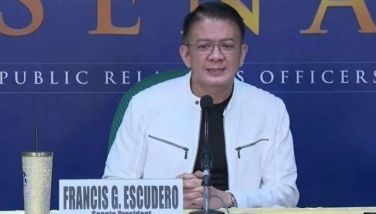Manuel Conde: A Filipino for Filipinos
It might seem rather odd that Manuel Conde, world famous director-actor of such costume pictures as Genghis Khan, Siete Infantes de Lara, Sigfredo (based on the German legend Niebelungen), Ibong Adarna would evolve into the voice of the common Filipino. His pictures set in Mongolia, Berbania, India, Spain, Vietnam would stir the imagination of the world, but it was in his depiction of Juan Tamad that he touched the Filipino soul.
In a ground-breaking adjunct of the Fourth Cinemalaya Film Festival and Competition held recently at the CCP, The Cinema of Manuel Conde written by Nicanor Tiongson was launched as the first book of a 12-part Directors Series conceived of by Cesar Hernando. This was followed by the screening of his internationally-acclaimed Genghis Khan from a dvd copy taped by movie aficionado Danny Dolor from a television cable screening while in the US. The following days saw the screening of his six remaining films, mostly from LVN, out of close to 70-some he directed in his lifetime.
Siete Infantes de Lara introduced to the industry Mario Montenegro (then billed George Collins) and Eddie Garcia who told us at the launch he was an “accidental actor” on leave from the military when he was cast. He never returned to the service and remains to this day one of the most versatile actor-directors active in the industry. Mario worked with Conde in his pictures Genghis Khan, Apat na Alas, Pilipino Kostum No Touch, Casa Grande, Venganza.
Also at the launch were Delia Razon who appeared in Señorito, El Robo, Apat na Alas, and Perla Bautista who appeared in Apat na Alas, Venganza, Bayanihan and Juan Tamad Goes to Society. They would be good sources of data on Conde, as well as Caridad Sanchez who appeared in Bayanihan, and Gloria Sevilla in Molave.
Genghis Khan directed when Conde was 35, for all its crudeness due to outdated equipment and obvious lack of funds became the first Filipino picture invited to compete in the Venice Film Festival of 1952 and was awarded a special prize. Critics of that period found it graphic and violent even in black and white, although we who have gotten used to the Sweeney Todds of today in red blood curdling color can’t imagine what could be so violent when there were neither heads being cut off to roll on the sand or people being boiled and burned to death.
Although it lost to Rene Clement’s Forbidden Games, it also competed with the likes of Charlie Chaplin, Ingmar Bergman, Federico Fellini, John Ford, Kenji Mizoguchi, William Wyler and was quickly bought by Jacques Grinieff of Hollywood (who had earlier acquired Conde’s Siete Infantes de Lara) for $50,000 which didn’t even pay for its production cost. When the film went on to earn $17-M, dubbed in 16 languages, Conde upon being chided for under-selling his creation quipped: “How was I to know it would win an award in Venice?”
Much of this humor found in his Juan Tamad series was intrinsic in the man himself. When an American writer called him a “one man studio” combining “the talents of Darryl F. Zanuck, Errol Flynn, Cecil B. De Mille and F. Hugh Herbert,” comparing him even to Orson Welles and a genius, Conde is known to have replied that his genius was born out of necessity and lack of money.
Like the true artist, Conde never really put much value on money, or awards, or movie credits as he was known to have given away his directorial credits to friends as a form of gratitude for their help. It is also obvious that although he appeared in most of his films, his multiple tasks on a movie were meant to save on expenses as he didn’t pay himself.
Conde who started directing for LVN Pictures in 1940 when he was 25, was entrusted by studio head Doña Sisang the difficult costume fantasy picture Ibong Adarna, meticulously hand-painted frame by frame. This was re-made by LVN in 1955. We watched the original version which already showed the makings of a genius. It had trick shots of people turning to stone, a mountain moving, a bottle of water turning into a sea, and a carriage and costume appearing from nowhere. We thought it was a pity Conde hadn’t yet met Botong Francisco then or he would have had a greater movie.
In 1947, he met Botong and both were inseparable since. And of course his remake of Ibong Adarna in epic proportions, apart from having Botong’s stunning costumes and sets starred the most popular love team of the time Nida Blanca and Nestor de Villa, and was the first local film shot in Eastman color. As expected, it was a big big hit.
As the fair-haired boy of LVN Pictures, Conde got some of the biggest and best assignments from the studio. His music was by Juan Silos and Francisco Buencamino Sr. and Jr., his cinematography by Emmanuel Rojas and Remigio Young, all icons in their time, and he had Doña Aurora Quezon, wife of President Quezon as lyricist of his debut film as director. Still, the young man was restless and wanted to spread his wings and fly. He put up his own production company to follow his dream.
Genghis Khan, produced by Conde’s Manuel Conde (MC) Productions lost money, jeered by the local audience accustomed to handsome large horses from the Hollywood Westerns very popular at the time. Conde, for lack of money, had to use little caretela horses for his production.
The little horses, however, were the toast of Europe. Apparently, in the time of Genghis Khan in Mongolia, the puny horses used for his army were already extinct in the ‘50s and Conde was praised for that touch of authenticity. Characteristically with humor, he told his growing listeners he had difficulty searching for such a breed all over the Philippine archipelago.
Although the international success of his films Siete Infantes de Lara, Sigfredo and Genghis Khan brought him many inquiries and projects in the offing, nothing came out of all the plans. But the experience enriched Conde’s appraisal of the movies within the context of the Philippines. For instance, it is stated in the book that he was surprised when asked if he was Mongolian, meaning that filmmakers were supposed to make pictures of their own experiences. After the Genghis Khan experience, it is said Conde decided to work only on Filipino material.
What really cemented him as the director for the Filipino people was his series on Juan Tamad. Started for his own productions early on in 1947 with Juan Tamad and Si Juan Daldal anak ni Juan Tamad, Conde returned in 1959 with Juan Tamad Goes to Congress, Juan Tamad Goes to Society, and Si Juan Tamad at si Juan Masipag sa Pulitikang Walang Hanggan. Although he only got to do five Juan Tamad movies (Juan Tamad Goes to College, to Business, to Jail, to Malacañang never got to be filmed), these few films got to be wildly popular, and spawned a TV series of Channel 13 in 1962 Under the Guava Tree with Juan Tamad, and Si Juan Tamad for Channel 4 in 1979 and there was no one both from the intelligentsia and on the streets who wasn’t aware of the character. If Juan Tamad were introduced today, there would be a Juan Tamad doll, a Juan Tamad mascot for Juan Tamad donuts, and a Juan Tamad song and dance over YouTube.
It is also significant that his son Jun Urbano chose a Mongolian (after Genghis Khan) to deliver his own brand of humor as his tribute to his dad’s Juan Tamad in the very popular character Mr. Shooli.
Was Conde then ahead of his time as an executive from Lebran Pictures stated way back in 1950? Perhaps he was, as are so many of the great artists of the world. Their recognition comes very often only after their deaths. With the highly-informative and analytical book from Tiongson, published through the assistance of the NCCA, UST Publishing House, Tribung Pilipino Cultural Foundation of Danny Dolor, and most specially the Urbano family, plus the few films salvaged from destruction, we are able to piece together what the man and artist stood for.
(E-mail me at bibsycarballo@yahoo.com.)
- Latest
- Trending

























 Exclusive
Exclusive






